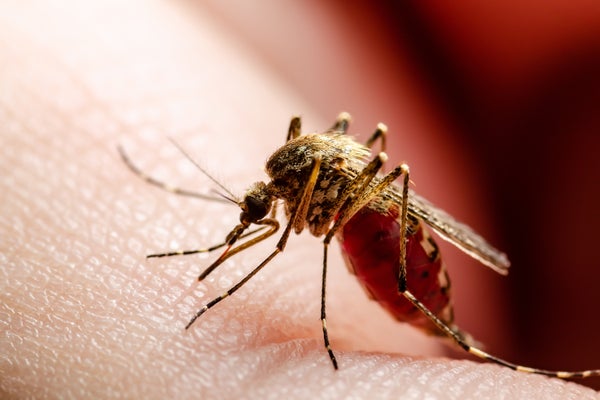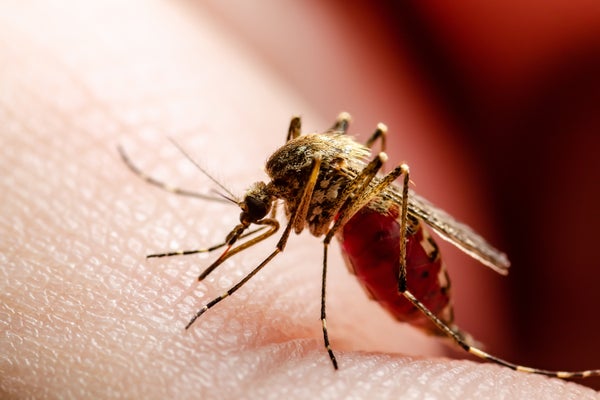August 12, 2024
3 min read
West Nile Cases Are Rising. Here’s How to Protect Yourself
West Nile is the most common mosquito-borne disease in the U.S. Here’s what to know about the infection

West Nile disease starts with a mosquito bite—but when bad luck strikes, the infection can end with dire illness and even death.
West Nile virus is present throughout the U.S. Nearly all cases occur between July and October, and the first human infections and deaths of the year have already been reported. That isn’t cause to panic—but it is reason to take precautions against the virus.
“West Nile has become established in the U.S.,” says Gonzalo Vazquez-Prokopec, a disease ecologist at Emory University. “We have to live with West Nile.”
On supporting science journalism
If you’re enjoying this article, consider supporting our award-winning journalism by subscribing. By purchasing a subscription you are helping to ensure the future of impactful stories about the discoveries and ideas shaping our world today.
The virus was first documented in the U.S. in 1999; its worst year to date came in 2003, when nearly 10,000 cases were reported. Since then infection levels have waxed and waned, likely as a result of climate factors and the species of birds that act as a reservoir for the virus, among other factors.
“In the beginning, 2002 and 2003 were really big years,” says Kristy O. Murray, an infectious disease specialist at Emory University. “We had another big outbreak year in 2012, and then I figure we’re kind of due for another one at this point.”

Whether 2024 will be a bad West Nile year is not yet clear. As of August 6, 103 human cases of the disease have been diagnosed in 26 different states this year. That’s lower than the 421 cases reported from January through July in 2023, but this year’s numbers are preliminary and may be influenced by reporting delays, making it difficult to draw conclusions. “West Nile virus tends to be unpredictable and varies from year to year, so we don’t know specifically how this year will be, compared to others,” says Erin Staples, a medical epidemiologist at the Centers for Disease Control and Prevention.
All told, just shy of 3,000 people in the U.S. have died of West Nile since 1999. But experts warn of the risks of underestimating the virus. Although most infections are asymptomatic, the virus triggers a fever in about 20 percent of people, and a small proportion of cases—about one in 150—are what doctors call “neuroinvasive,” meaning they reach the brain, triggering encephalitis, or the spinal cord, triggering meningitis.
In either scenario, neuroinvasive West Nile can lead to serious consequences. People can develop a stiff neck and devastating headache. “They’ll say it’s the worst headache they’ve had in their entire life,” Murray says. And because there’s no specialized treatment for the disease, doctors can only treat the symptoms and hope for the best. Many people with a neuroinvasive infection never fully recover. “Our meningitis cases, about 40 percent of them never returned back to their baseline status, and for our encephalitis cases, [that figure] was 80 percent,” Murray says.
Scientists don’t know what determines how serious a West Nile infection will be. “Most people do not get neuroinvasive disease,” says Robyn S. Klein, a physician and neuroimmunologist at Western University in Ontario. Older people and immunocompromised people appear to be more likely to develop worse cases of West Nile, but young and healthy people can still get sick. “It’s unclear exactly why some people get invasive disease,” she adds.
Right now there’s no approved vaccine for West Nile. Though several candidates have displayed promising results in early testing, efforts have slowed because of a lack of profit incentive. And the virus will likely never disappear because it is transmitted by several different mosquito species and primarily infects birds, which, unlike humans, can’t follow public health guidelines.
The only foolproof way to avoid the disease is to avoid being bitten by mosquitoes that carry the virus. West Nile is most common in mosquitoes of the genus Culex, although other types can carry it as well. And Culex mosquitoes like spending time around humans and bacteria-rich environments, Vazquez-Prokopec says. “They are the roach of mosquitoes,” he adds. “They have evolved and adapted, really, to bite people and live in urban areas.”
Local governments often try to kill off mosquitoes with pesticides or habitat elimination, but Murray cautions people against relying entirely on these efforts to keep safe from West Nile. “While you do as much as you can to try and reduce those populations, it’s not a perfect science,” Murray says. “It’s always a challenge.”
Because these insects bite most at night, people who live where Culex mosquitoes are common should take extra precautions against mosquitoes during that time. In particular, Vazquez-Prokopec recommends wearing long sleeves and pants, using CDC-approved repellents to reduce bites and getting used to taking mosquito risk seriously. “The future of urban living in the U.S. is, in a way, a buggier future,” he says.

